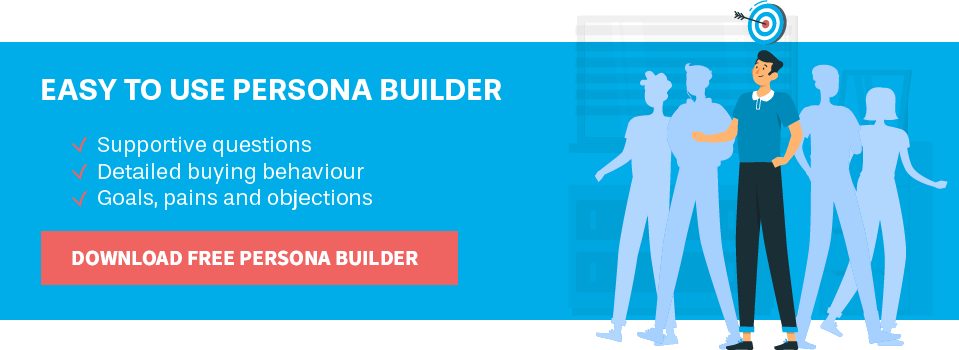How to build your perfect target persona
You’ve likely heard of having a target audience, but what you might not know about are target personas. These are profiles of individuals who are in your target audience, created by research, knowledge of current/past customers and a little bit of imagination. We will break down for you why they are important and the best ways to build your persona from scratch.
Why do you need one?
Personas give you the power to tailor your content, services and products, building to the specific needs and behaviours of different groups.
Your target customers are restaurant managers but do you know what their interests and specific needs are? What is their background? When is the best time to start conversations with them? What devices do they use daily? If you don’t know what makes your potential customers tick, how can you engage with them?
By utilising your knowledge of your target audience and creating content with that knowledge in mind, you will automatically start to build more trust with those you are looking to sell to. This is because you are showing your understanding of their problems and actively bringing them solutions, rather than just talking about yourselves. While talking about yourself as a brand has its time and place (think ‘about us’ pages and social media bios) to build trust, it is not as effective.
You may even find that you have more than one persona for each service or product you offer- it is best to explore as many as possible. It’s time to put in the work and learn all about them!
How to build your target persona
1. Look at past and current clients
A great place to start is to focus on your past and current clients, and look at their data. Learn more about their pain points – reference previous engagements, phone calls or even emails. Remember that time they found it difficult to visualise what they wanted or get the product they desperately needed? How did you handle this scenario and what was the outcome?
Being able to anticipate your customer’s problems with solutions is the key to generating sales.
2. Talk to your team
If you have a sales or customer service team, conduct interviews with them. They interact with your client base daily and will have great insights into your customer behaviour. Also possibly even geographical information which can help with segmentation.
3. Review your previous conversations with your clients
Don’t forget to check your online conversations with your customers, such as reviews and social media posts. Also have a look at what your competitor’s customers are talking about, afterall you’re marketing to the same people! Listen to what customers love and what companies can improve on. Start to take note of the type of people making noise. Consider their age, gender and the time of day people are talking.
For those who are working in a startup, this can be particularly challenging, as they don’t have previous customers to look back on. Instead, analysing the audience of your closest competitors can provide this much needed insight. While you may not be able to know exactly who their customers are and their contact lists for email campaigns, you can look through their social media followers. From this, you can find their audience base and what demographics typically use your competitors. Maybe they attract middle-aged businessmen with families, or maybe it’s younger women who enjoy travelling. You won’t know until you look!
So now you have a slightly better idea of your potential persona. It could be a female social media assistant in the hospitality industry, a 30 year old account manager working in manufacturing or even a young mum living in the country with a newborn baby.

Give the target persona an identity
1. Visualise the person
Start by filling out basic information with a picture to help visualise them in the most realistic way. If you are creating several personas to hit different levels within one company, it is always useful to name them by statuses such as Director Dave, Manager Magaret or Assistant Adam, to help you to remember which persona you are identifying with.
2. Two facets of life
Everyone has at least two sides to their life- work and home. To better understand your persona, you need to think about both facets of their life. This will help to ways to market and the tone to use when engaging with your persona.
Think about who this person may be in their personal life and what do they do in their free time:
- Do they have a family?
- Do they have any good or bad habits?
- What are their hobbies, likes and dislikes?
Once you are able to see this side of them, you start to understand them as an actual, fully rounded person.
Next, start to think about them in their working environment. Consider if they enjoy their job, or find it fulfilling. How do they interact with their colleagues or bosses?
For example, if your persona is female and works in an office surrounded mostly by men, she could be assertive and straight-talking in order to garner respect. From this, you will be able to create the most impactful marketing message in the most appropriate tone.
3. What does your target audience want and need?
Whether you work in B2B or B2C selling, it is important to have a good understanding of your personas goals/motivations and barriers/challenges. While your product or service is fantastic, you need to understand its true benefit to them instead of listing information that they have no need for.
Make your marketing message elevated by understanding these areas of the persona you are marketing to. Fine-tune your message knowing all of the above, speak in their language, explain to them why your product or service will improve their work and life. Make note of your KEY messages based on that information.
Remember the key message is all about THEM and what they NEED, not you and your product features.
4. How does your target persona make decisions
It’s time to plot how you’re going to get in there and really grab your persona’s attention. How could they continue without your product or service that is going to make their life so much better they couldn’t possibly turn down the offer? Think about the buying scenario. Are they a key decision-maker or an influencer?
If they are in a high position of power, like a director, you need to understand what their day could look like and how they prefer information to be presented to them. They don’t have time. You want to get in front of them, show them the proposal with all the information, leaving no page unturned as quickly and efficiently as possible.
Also, consider factors such as when your persona is most likely to be busy. If your persona works in the head office in any retail environment chances are you’re not going to get a meeting on a Monday due to trade, or even a Tuesday. It’s better to target them towards the end of the week.
You can look at trade shows, online forums and blogs in regards to the sector your persona works in to gain extra insight. The more you get to understand and the more time spent targeting at the right time of day, and even the right time of year, the better your chances are of getting in!
3 stages of target persona online behaviour
1. Awareness stage
During this stage, they even don’t know you exist. They might not even know that the type of your service exists. This is a stage where they find out and DISCOVER your/ your product/ service. The content at this stage might include social media content (think YouTube videos and influencers talking about the subject), blog posts and infographics. This stage is all about learning and getting educated on the matter at hand.
When thinking about your sales funnel, these people would be at the ‘top of the funnel’ or TOFU for short.
For example, the persona finds out that they are gluten intolerant and are searching online for more information about this- such as how and why it affects them, or how other people manage it.
2. Evaluation stage
This is a stage where they know you and your competitors. Or they know the type of your service and compare it to other solutions. Content here can include downloadable resources, surveys and web pages of companies.
The evaluation stage is very much the ‘middle of the funnel’ (MOFU), where people need a little bit of extra information to pull them further down.
For example, the persona finds out that there are different types of gluten-free food and learns that the best is oatmeal.
3. Decision stage
Decision (Select) – This is a stage where the persona looks for information that can help her make a decision on what option/service they should choose. When it comes to thinking about content in this stage, it will be focused on the comparison (such as benefits and prices), direct contact with the brand and even case studies.
‘Bottom of the funnel (BOFU) customers are those who are most likely to benefit from direct contact from your sales team, as will you as they are the ones who will be making the payments.
For example, the persona finds different products of gluten-free oatmeal and makes a decision on which one to choose.
Creating buyer personas will enable you to produce content and launch campaigns that resonate with your audience while helping you to grow your brand and change to your customer’s needs. In following the steps presented to you, you will be able to create at least three key buyer personas for your company and start getting yourself in front of the right customers at the right time.
If you find that you need further assistance in making your personas and lining up your marketing efforts in response to your personas, get in touch to arrange a free, 30-minute consultation.






